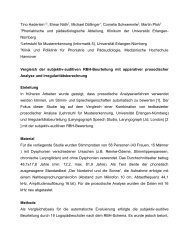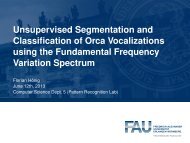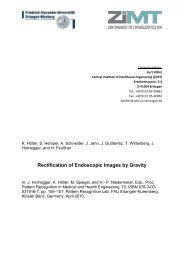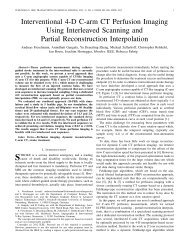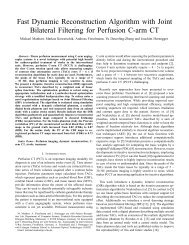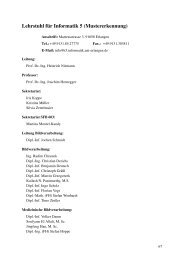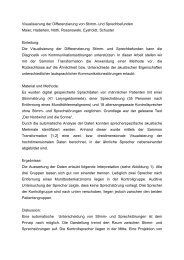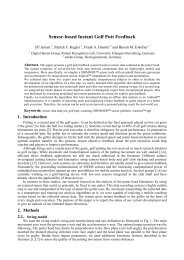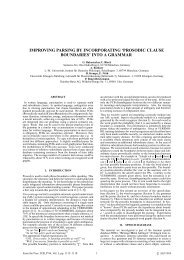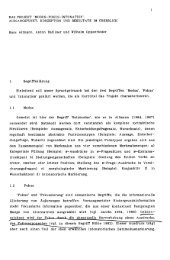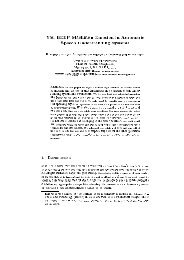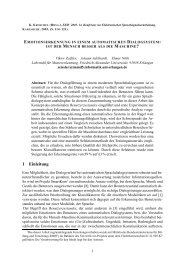Error Estimation of SPECT OSEM with 3D Resolution Recovery ...
Error Estimation of SPECT OSEM with 3D Resolution Recovery ...
Error Estimation of SPECT OSEM with 3D Resolution Recovery ...
Create successful ePaper yourself
Turn your PDF publications into a flip-book with our unique Google optimized e-Paper software.
2008 IEEE Nuclear Science Symposium Conference Record M06-305<br />
Towards Quantitative <strong>SPECT</strong>: <strong>Error</strong> <strong>Estimation</strong> <strong>of</strong><br />
<strong>SPECT</strong> <strong>OSEM</strong> <strong>with</strong> <strong>3D</strong> <strong>Resolution</strong> <strong>Recovery</strong>,<br />
Attenuation Correction and Scatter Correction<br />
J. Zeintl, Student Member, IEEE, A. H. Vija, Member, IEEE, A. Yahil, Member, IEEE, X. Ding, Member, IEEE, J.<br />
Hornegger, Member, IEEE, and T. Kuwert<br />
Abstract– In this study we systematically investigate biases<br />
relevant to quantitative <strong>SPECT</strong> if <strong>OSEM</strong> <strong>with</strong> isotropic (<strong>3D</strong>)<br />
depth dependent resolution recovery (<strong>OSEM</strong>-<strong>3D</strong>), attenuation<br />
and scatter correction is used. We focus on the dependencies <strong>of</strong><br />
activity estimation errors on the projection operator, structure<br />
size, pixel size, count density and reconstruction parameters. We<br />
use Tc-99m to establish a base line. Four Siemens low energy<br />
collimators (Low Energy Ultra High <strong>Resolution</strong>, Low Energy<br />
High <strong>Resolution</strong>, Low Energy All Purpose, Low Energy High<br />
Sensitivity) <strong>with</strong> geometric resolution between 4.4 mm and 13.1<br />
mm at 10 cm distance and sensitivity between 100 cpm/μCi and<br />
1020 cpm/μCi are tested <strong>with</strong> simulations <strong>of</strong> spheres <strong>with</strong><br />
diameters between 9.8 mm and 168 mm in background. Pixel<br />
sizes and total counts are varied between 2.4 mm and 9.6 mm and<br />
0.125 and 32 million counts. Images are reconstructed <strong>with</strong><br />
<strong>OSEM</strong>-<strong>3D</strong> (Flash<strong>3D</strong>) <strong>with</strong> attenuation and scatter correction.<br />
Emission recovery is quantitatively measured for different<br />
reconstruction parameter settings. In addition, physical<br />
measurements <strong>of</strong> standard quality control phantoms are<br />
performed using an actual <strong>SPECT</strong>/CT system (Symbia® T6).<br />
Cross calibration <strong>of</strong> the imaging system <strong>with</strong> a well counter and<br />
results from simulations are used to quantitatively estimate the<br />
true activity concentration in the physical phantoms. Results<br />
show variations <strong>of</strong> emission recovery between 13.8% and 104.5%<br />
depending on sphere volume and number <strong>of</strong> <strong>OSEM</strong>-<strong>3D</strong> updates.<br />
After correction for the emission recovery errors and cross<br />
calibration <strong>of</strong> the imaging system the errors in absolute<br />
quantitation using the physical sphere phantom are between<br />
+0.01±0.61% for the largest (16 ml) and -5.87±1.00% for the<br />
smallest (0.5 ml) sphere. As a conclusion, the emission recovery<br />
varies over a wide range and is highly dependent on imaging<br />
parameters when using <strong>OSEM</strong>-<strong>3D</strong> reconstruction. Accurate<br />
quantitation in phantoms is possible given that errors at the<br />
specific imaging operation point can be estimated. In a clinical<br />
setup this is a nontrivial task, and perhaps too cumbersome for<br />
routine clinical use.<br />
Manuscript received November 14, 2008. Asterisk indicates corresponding<br />
author.<br />
*Johannes Zeintl is a PhD student <strong>with</strong> the University <strong>of</strong> Erlangen-<br />
Nuremberg, Institute <strong>of</strong> Pattern Recognition, Erlangen, Germany. (e-mail:<br />
Johannes.Zeintl@uk-erlangen.de).<br />
A. Hans Vija, Ding Xinhong are <strong>with</strong> Siemens Medical Solution USA,<br />
Inc., Molecular Imaging, H<strong>of</strong>fman Estates, IL 60192, USA.<br />
Amos Yahil is <strong>with</strong> Image Recon LLC, Stony Brook, NY, USA.<br />
Joachim Hornegger is <strong>with</strong> the University <strong>of</strong> Erlangen-Nuremberg,<br />
Institute <strong>of</strong> Pattern Recognition, Erlangen, Germany.<br />
Torsten Kuwert is <strong>with</strong> the University <strong>of</strong> Erlangen-Nuremberg, Clinic <strong>of</strong><br />
Nuclear Medicine.<br />
I. INTRODUCTION<br />
N clinical <strong>SPECT</strong> imaging iterative reconstruction<br />
Itechniques are now a common alternative to filtered<br />
backprojection [5]. Ordered subset expectation<br />
maximization (<strong>OSEM</strong>) is <strong>of</strong>ten the iterative method <strong>of</strong> choice<br />
([3], 10]). The advantage <strong>of</strong> iterative methods is the ability to<br />
correct for image degradations introduced by imaging physics<br />
such as depth dependent blur, photon attenuation, and scatter.<br />
It was shown that these corrections minimize errors for<br />
absolute quantitation in <strong>SPECT</strong> imaging ([2], [9], [11], [12]).<br />
Active research is conducted to improve correction techniques<br />
for quantitation in <strong>SPECT</strong> ([16] – [20]) and to evaluate<br />
common reconstruction methods and establish practical<br />
baselines ([4], [6], [13], [15]). However, less attention was<br />
paid to the non-stationary behavior <strong>of</strong> <strong>OSEM</strong> in terms <strong>of</strong><br />
quantitation and the dependency <strong>of</strong> quantitation errors on<br />
imaging parameters. In this work we systematically<br />
investigate biases relevant to quantitative <strong>SPECT</strong> if <strong>OSEM</strong><br />
<strong>with</strong> isotropic (<strong>3D</strong>) depth dependent resolution recovery<br />
(<strong>OSEM</strong>-<strong>3D</strong>), attenuation and scatter correction is used. We<br />
focus on the dependencies <strong>of</strong> activity estimation errors on the<br />
projection operator, structure size, pixel size, count density,<br />
and reconstruction parameters. We use the obtained results to<br />
correct for the non-stationarity <strong>of</strong> <strong>OSEM</strong> in physical phantom<br />
experiments performed on a cross-calibrated <strong>SPECT</strong>/CT<br />
system.<br />
II. MATERIAL AND METHODS<br />
Three steps were performed to derive absolute values for<br />
activity concentrations from reconstructed images <strong>of</strong> actual<br />
measured data:<br />
A: <strong>Estimation</strong> <strong>of</strong> emission recovery errors for various<br />
imaging parameter sets using simulations.<br />
B: Cross calibration <strong>of</strong> the <strong>SPECT</strong>/CT imaging system <strong>with</strong><br />
the well counter.<br />
C: Appliance <strong>of</strong> correction factors derived from A and B to<br />
measured phantom data.<br />
978-1-4244-2715-4/08/$25.00 ©2008 IEEE<br />
4106
A. Simulations <strong>of</strong> imaging system<br />
Quasi-analytical simulations (voxel size: 0.6 mm) are<br />
performed by modeling the projection operator in <strong>3D</strong><br />
according to the detector and collimator specifications <strong>of</strong> the<br />
Siemens Symbia T-series gamma cameras <strong>with</strong> the parameters<br />
listed in Table I, and assuming a perfect collimator. Poisson<br />
noise is added to the generated projection data. Photon<br />
attenuation in the object is accounted for and a derived μ-map<br />
is used for attenuation correction. We assume an acquisition<br />
<strong>with</strong> perfect scatter rejection <strong>of</strong> 140keV (Tc-99m) photons.<br />
for a given object j at a given imaging parameter set i. The<br />
boundaries <strong>of</strong> the target object to be measured are derived<br />
from the true high resolution image (Fig. 1 top row). Partial<br />
volume effects, specifically spill-in and spill-out at the object<br />
boundaries due to finite pixel size, are compensated for by<br />
measuring the loss <strong>of</strong> emission in the simulation using<br />
different pixel sizes.<br />
B. Cross Calibration <strong>of</strong> the Imaging System<br />
TABLE I<br />
COLLIMATOR SPECIFICATIONS OF FOUR SIEMENS LOW ENERGY COLLIMATORS<br />
Acceptance<br />
Angle (rad)<br />
Sensitivity<br />
(cpm/μCi)<br />
Hole Length<br />
(mm)<br />
Geometric<br />
<strong>Resolution</strong> @<br />
10cm (mm)<br />
LEHS 0.115194 1020 24.05 13.4<br />
LEAP 0.064973 330 24.05 7.6<br />
LEHR 0.049514 202 24.05 5.9<br />
LEUHR 0.034632 100 35.8 4.4<br />
LEHS: Low Energy High Sensitivity, LEAP: Low Energy All Purpose, LEHR:<br />
Low Energy High <strong>Resolution</strong>, LEUHR: Low Energy Ultra High <strong>Resolution</strong><br />
Hot spheres <strong>with</strong> diameters between 9.8 mm and 168 mm in a<br />
warm cylindrical background (Sphere to background ratio<br />
10:1) are simulated. Pixel size and total counts are varied<br />
between 2.4 mm and 9.6 mm and 0.125 and 32 million counts.<br />
Image reconstruction is performed using MLEM/<strong>OSEM</strong> <strong>with</strong><br />
isotropic resolution recovery (Flash<strong>3D</strong>) and attenuation<br />
correction. Fig. 1 shows example images <strong>of</strong> simulated and<br />
reconstructed spheres.<br />
Fig. 1: True (top row) and example reconstructed images (bottom row, LEHR<br />
collimation, 2.4 mm voxel, 32 <strong>OSEM</strong> updates) <strong>of</strong> the simulated spheres <strong>of</strong><br />
different diameters in a 10% background.<br />
Images are analyzed in terms <strong>of</strong> emission recovery. The<br />
emission recovery coefficient is defined as:<br />
( j i)<br />
( j)<br />
Measured Emission ,<br />
C E<br />
( j, i)<br />
= , (1)<br />
True Emission<br />
Fig. 2: Acquisition setup for the cross calibration <strong>of</strong> the imaging system. A<br />
large cylindrical phantom is filled uniformly <strong>with</strong> a known activity<br />
concentration derived from a well counter and acquired in the <strong>SPECT</strong>/CT<br />
imaging system.<br />
The cross calibration <strong>of</strong> the <strong>SPECT</strong>/CT system is done<br />
using a large cylindrical phantom uniformly filled <strong>with</strong> water<br />
and a known activity concentration <strong>of</strong> Tc-99m measured in a<br />
well counter (see Fig. 2). 50 million total counts are collected<br />
in a 360 degree acquisition range, 120 projections, and a 150<br />
mm detector radius from the center <strong>of</strong> rotation. A dual energy<br />
window was used for the acquisition <strong>of</strong> the photo peak and the<br />
lower scatter (15% window width, respectively). An<br />
attenuation map was generated from a CT scan <strong>of</strong> the<br />
phantom. Data are reconstructed using <strong>OSEM</strong> <strong>with</strong> isotropic<br />
beam modeling (Flash<strong>3D</strong>) and scatter and attenuation<br />
correction.<br />
To calculate the system volume sensitivity a large volume<br />
<strong>of</strong> interest (> 3000 ml) is drawn and the count rate per volume<br />
is derived. The decay corrected count rate is calculated as<br />
follows:<br />
ˆ<br />
⎛ T − T ⎞ ⎛<br />
0 ln 2 ⎞⎛<br />
⎛ ⎞⎞<br />
exp ln 2 ⎜1<br />
exp ln 2 ⎟<br />
×<br />
t<br />
R = R ×<br />
⎜ ⎟<br />
⎜<br />
⎟<br />
−<br />
⎜ −<br />
⎟ (2)<br />
⎝ T1/<br />
2 ⎠ ⎝ T1/<br />
2 ⎠⎝<br />
⎝ T1/<br />
2 ⎠⎠<br />
Where R is the count rate derived from the reconstructed<br />
image, T is the start time <strong>of</strong> the acquisition, T 0 is the time <strong>of</strong><br />
the activity calibration, T 1/2 is the half time <strong>of</strong> the isotope, and<br />
t is the time duration <strong>of</strong> the acquisition.<br />
The system volume sensitivity is then:<br />
−1<br />
4107
S<br />
Rˆ<br />
/ t<br />
Dwell<br />
Vol<br />
= (3)<br />
cA<br />
Where t Dwell is the total dwell time <strong>of</strong> the acquisition (t Dwell =<br />
t in continuous acquisition mode) and c A is the actual activity<br />
concentration in the phantom measured by the well counter.<br />
C. Appliance <strong>of</strong> corrections on real phantom data<br />
To evaluate the quantitative accuracy <strong>of</strong> the <strong>SPECT</strong>/CT<br />
imaging system a standard quality control sphere phantom<br />
(Data Spectrum, Hillsborough, NC) is acquired. The activity<br />
concentration is 19.6 μCi/ml (725 kBq/ml) in the spheres and<br />
1.7 μCi/ml (63 kBq/ml) in the background, resulting in a<br />
concentration ratio <strong>of</strong> approx. 12:1. The phantom is acquired<br />
in the center <strong>of</strong> the field <strong>of</strong> view using a 150 mm detector<br />
radius <strong>of</strong> rotation over a 360° scan range. LEHR collimation is<br />
used <strong>with</strong> a 2.4 mm pixel size. The total number <strong>of</strong> counts is<br />
24 million.<br />
The data are reconstructed <strong>with</strong> Flash<strong>3D</strong> <strong>with</strong> scatter and<br />
CT based attenuation correction. Volumes <strong>of</strong> interest are<br />
drawn manually using the CT boundaries <strong>of</strong> the fused<br />
<strong>SPECT</strong>/CT image (see Fig. 3). The absolute activity<br />
concentration for a given object size j is calculated by<br />
( j)<br />
/ t<br />
Dwell<br />
C ( j,<br />
i′<br />
)<br />
RVOI<br />
cˆ A<br />
( j)<br />
=<br />
, (4)<br />
S<br />
Vol<br />
where R VOI is the count rate per volume in the drawn<br />
volume <strong>of</strong> interest and i’ the specific imaging parameter set<br />
used.<br />
E<br />
Fig. 3: Reconstructed image <strong>of</strong> the sphere phantom fused <strong>with</strong> the CT image<br />
(LEHR collimation, 2.4 mm voxel, 32 <strong>OSEM</strong> updates). Volumes <strong>of</strong> interest<br />
were drawn manually using the CT boundaries.<br />
III. RESULTS<br />
A. Simulation Results<br />
In Fig. 4 the loss <strong>of</strong> emission recovery due to spill over at<br />
the object boundaries is shown for the different object and<br />
voxel sizes used. The values are derived from the simulation<br />
tool when a target to background ratio <strong>of</strong> 10:1 is used. In<br />
subsequent results these values are applied as a postprocessing<br />
step after reconstruction to compensate for the<br />
effect by adding the respective value to the emission recovery<br />
coefficients measured in the simulations.<br />
Measured Emission <strong>Recovery</strong> in Object<br />
120%<br />
100%<br />
80%<br />
60%<br />
40%<br />
20%<br />
0%<br />
0 30 60 90 120 150<br />
Sphere Diameter (mm)<br />
2.4 mm voxel<br />
4.8 mm voxel<br />
9.6 mm voxel<br />
Fig. 4: The effect <strong>of</strong> spill over at object boundaries on emission recovery due<br />
to finite voxel size for different object and voxel sizes (target to background<br />
ratio is 10:1).<br />
Fig. 5 gives an overview <strong>of</strong> the emission recovery<br />
coefficients for different object sizes, number <strong>of</strong> <strong>OSEM</strong><br />
updates, and voxel sizes used. Results are shown for LEHR<br />
collimation and 2 million total counts. For small object and<br />
voxel sizes (2.4 mm, 4.8 mm) the over shooting characteristic<br />
<strong>of</strong> <strong>OSEM</strong> at high numbers <strong>of</strong> updates is visible. In general the<br />
emission recovery coefficient is highly dependent on the<br />
number <strong>of</strong> <strong>OSEM</strong> updates especially for object sizes below 3<br />
times the system resolution. This dependency at small object<br />
sizes is more pronounced for finer data sampling (smaller<br />
voxels).<br />
The dependency <strong>of</strong> emission recovery on the projection<br />
operator is shown in Fig. 6. The recovery coefficient for<br />
LEUHR, LEAP, and LEHS collimation is shown using 2.4<br />
mm voxel size, and 1 million, 4.5 million, and 10 million total<br />
counts for LEUHR, LEAP, and LEHS collimation,<br />
respectively. At small object sizes the effect <strong>of</strong> the beam<br />
geometry on the emission recovery is noticeable and results in<br />
lower values for broader beam collimators.<br />
4108
<strong>Recovery</strong> Coefficient<br />
<strong>Recovery</strong> Coefficient<br />
<strong>Recovery</strong> Coefficient<br />
1.2<br />
1<br />
0.8<br />
0.6<br />
0.4<br />
0.2<br />
LEHR 2.4 mm Voxel Size<br />
0<br />
0 5 10 15<br />
1.2<br />
1<br />
0.8<br />
Sphere Diameter (mm)<br />
0 30 60 90 120 150<br />
Sphere Diameter (mm) / System <strong>Resolution</strong> (mm)<br />
LEHR 4.8 mm Voxel Size<br />
128 upds<br />
64 upds<br />
32 upds<br />
16 upds<br />
8 upds<br />
4 upds<br />
0.6<br />
128 upds<br />
64 upds<br />
0.4<br />
32 upds<br />
16 upds<br />
0.2<br />
8 upds<br />
4 upds<br />
0<br />
0 5 10 15<br />
1.2<br />
1<br />
0.8<br />
0.6<br />
0.4<br />
0.2<br />
0<br />
Sphere Diameter (mm)<br />
0 30 60 90 120 150<br />
Sphere Diameter (mm) / System <strong>Resolution</strong> (mm)<br />
LEHR 9.6 mm Voxel Size<br />
Sphere Diameter (mm)<br />
0 30 60 90 120 150<br />
128 upds<br />
64 upds<br />
32 upds<br />
16 upds<br />
8 upds<br />
4 upds<br />
0 5 10 15<br />
Sphere Diameter (mm) / System <strong>Resolution</strong> (mm)<br />
Fig. 5: Emission recovery coefficients for different object sizes, number <strong>of</strong><br />
<strong>OSEM</strong> updates, and voxel sizes using LEHR collimation and 2 million total<br />
counts. Values are corrected for spill over effects at the object boundaries<br />
using results <strong>of</strong> Fig. 4. Each data point is obtained using the average value <strong>of</strong><br />
5 independent realizations.<br />
<strong>Recovery</strong> Coefficient<br />
<strong>Recovery</strong> Coefficient<br />
<strong>Recovery</strong> Coefficient<br />
1.2<br />
1<br />
0.8<br />
0.6<br />
0.4<br />
0.2<br />
1.2<br />
1<br />
0.8<br />
0.6<br />
0.4<br />
0.2<br />
LEUHR 2.4 mm Voxel Size<br />
Sphere Diameter (mm)<br />
0 30 60 90 120 150<br />
0<br />
0 5 10 15 20<br />
1.2<br />
1<br />
0.8<br />
0.6<br />
0.4<br />
0.2<br />
Sphere Diameter (mm) / System <strong>Resolution</strong> (mm)<br />
LEAP 2.4 mm Voxel Size<br />
0<br />
0 5 10<br />
LEHS 2.4 mm Voxel Size<br />
128 upds<br />
64 upds<br />
32 upds<br />
16 upds<br />
8 upds<br />
4 upds<br />
Sphere Diameter (mm)<br />
0 30 60 90 120 150<br />
128 upds<br />
64 upds<br />
32 upds<br />
16 upds<br />
8 upds<br />
4 upds<br />
Sphere Diameter (mm) / System <strong>Resolution</strong> (mm)<br />
Sphere Diameter (mm)<br />
0 30 60 90 120 150<br />
128 upds<br />
64 upds<br />
32 upds<br />
16 upds<br />
8 upds<br />
4 upds<br />
0<br />
0 2 4 6 8<br />
Sphere Diameter (mm) / System <strong>Resolution</strong> (mm)<br />
Fig. 6: Emission recovery coefficients for different object sizes, number <strong>of</strong><br />
<strong>OSEM</strong> updates, and collimation schemes using 2.4 mm voxels and 1 million,<br />
4.5 million, and 10 million total counts for LEUHR, LEAP, and LEHS<br />
collimation, respectively. Values are corrected for spill over effects at the<br />
object boundaries using results <strong>of</strong> Fig. 4. Each data point is obtained using the<br />
average value <strong>of</strong> 5 independent realizations.<br />
4109
The dependency <strong>of</strong> total counts on the emission recovery is<br />
shown in Fig. 7. Beyond 3 times the system resolution the<br />
standard deviation <strong>of</strong> the recovery coefficient is below 0.0035<br />
for all count levels tested. Below this point standard deviations<br />
are between 0.0056 and 0.0233 for 16ml and 0.5ml spheres,<br />
respectively.<br />
<strong>Recovery</strong> Coefficient<br />
1.2<br />
1.1<br />
1<br />
0.9<br />
0.8<br />
0.7<br />
0.6<br />
0.5<br />
Sphere Diameter (mm)<br />
0 30 60 90 120 150<br />
0.125 Mcts<br />
0.500 Mcts<br />
1 Mcts<br />
2 Mcts<br />
4 Mcts<br />
16 Mcts<br />
32 Mcts<br />
0.4<br />
0 5 10 15<br />
Sphere Diameter (mm) / System <strong>Resolution</strong> (mm)<br />
Fig. 7: Emission recovery coefficients for different total count levels using<br />
LEHR collimation, 2.4 mm voxel size and 32 <strong>OSEM</strong> updates. Each data point<br />
is obtained using the average value <strong>of</strong> 5 independent realizations.<br />
B. Quantitative Results from Phantom Experiment<br />
Using the simulated recovery coefficient for the specific<br />
operation point <strong>of</strong> the phantom experiment (Section II C)<br />
which is between 0.485 and 0.898 for the smallest and the<br />
largest sphere respectively and applying Equation 4, the<br />
absolute activity concentrations are calculated for all 6<br />
spheres. The results are summarized in Table II showing<br />
absolute quantification errors between -5.87% and 0.01% for<br />
the smallest and largest sphere, respectively.<br />
Reference Values*<br />
Sphere<br />
Volume<br />
(ml)<br />
TABLE II<br />
RESULTS FROM PHANTOM EXPERIMENT<br />
Activity<br />
Concentratio<br />
n (μCi/ml)<br />
VOI Mean<br />
Volume<br />
(ml)<br />
Image Based<br />
Calculated<br />
Mean<br />
Activity<br />
Concentratio<br />
n (μCi/ml)<br />
Activity<br />
Concentratio<br />
n Standard<br />
Deviation**<br />
(μCi/ml)<br />
Difference -<br />
Reference<br />
vs.<br />
Calculated<br />
(%)<br />
16 16.3 19.59 0.12 -0.01 ± 0.61<br />
8 8.2 20.03 0.13 +2.25 ± 0.66<br />
4 4.1 20.11 0.29 +2.62 ± 1.48<br />
19.6<br />
2 2.0 19.60 0.22 +0.02 ± 1.15<br />
1 1.1 18.65 0.34 -4.81 ± 1.73<br />
0.5 0.6 18.44 0.19 -5.87 ± 1.00<br />
*according to manufacturer specifications and well counter measurements<br />
**manual determination <strong>of</strong> VOIs by 2 operators, 2 repeats each<br />
IV. DISCUSSION<br />
The object evaluated in the phantom experiment<br />
geometrically correlates well to the objects in the simulation,<br />
i.e. object sizes and positions are similar. In addition, the<br />
scanner geometry including e.g. detector orbit and radius, <strong>of</strong><br />
simulation and experiment is kept identical. Thus,<br />
dependencies <strong>of</strong> geometric conditions on the emission<br />
recovery are disregarded.<br />
The method used to simulate the imaging system only takes<br />
the primary photons <strong>of</strong> 140 keV into account, neglecting both<br />
septal penetration as well as object and collimator scattering.<br />
These effects are present in the real data even though<br />
corrected using the standard techniques provided by the<br />
reconstruction s<strong>of</strong>tware package. These inconsistencies might<br />
introduce errors.<br />
During the cross calibration step for obtaining the system<br />
volume sensitivity additional errors are introduced due to both<br />
systematic and statistical errors <strong>of</strong> physical volume and<br />
activity measurements.<br />
In the phantom experiment the object boundaries are drawn<br />
manually resulting in variable size and shape even though<br />
fused CT data is used. To create reproducible results and for<br />
use in clinical workflows automatic or semi automatic<br />
segmentation tools are preferable.<br />
The developed procedure shows promising results for<br />
absolute quantitation in <strong>SPECT</strong>. However, a careful analysis<br />
incorporating all the various sources <strong>of</strong> error is required, in<br />
order to make this procedure more universally valid.<br />
V. CONCLUSION<br />
Results from simulations show that the emission recovery<br />
varies over a wide range and is highly dependent on imaging<br />
parameters when using <strong>OSEM</strong>-<strong>3D</strong> reconstruction. Highest<br />
variations are in the clinical relevant domain below three times<br />
the imaging system resolution. Accurate quantitation in<br />
phantoms is possible given that errors at the specific imaging<br />
operation point can be estimated. In a clinical setup this is a<br />
nontrivial task, and perhaps too cumbersome for routine<br />
clinical use.<br />
ACKNOWLEDGMENTS<br />
The authors would like to thank Ron Malmin and Manjit<br />
Ray for valuable discussions and the Systems Test team at<br />
H<strong>of</strong>fman Estates for their help during system quality control<br />
and acquisition <strong>of</strong> the data.<br />
REFERENCES<br />
[1] H. H. Barrett, and e. al., “Noise Properties <strong>of</strong> the EM algorithm: I.<br />
Theory,” Physics in Medicine and Biology, vol. 39, pp. 833-846, 1994.<br />
[2] D. R. Gilland, R. J. Jaszczak, J. E. Bowsher et al., “Quantitative <strong>SPECT</strong><br />
Brain Imaging: Effects <strong>of</strong> Attenuation and Detector Response,” Nuclear<br />
Science, IEEE Transactions on, vol. 40, no. 3, pp. 295-299, 1993.<br />
[3] H. M. Hudson, and R. S. Larkin, “Accelerated Image Reconstruction<br />
using Ordered Subsets <strong>of</strong> Projection Data,” Medical Imaging, IEEE<br />
Transactions on, pp. 100-108, 1994.<br />
[4] C. Kamphuis, F. J. Beekman, and M. A. Viergever, “Evaluation <strong>of</strong> OS-<br />
EM vs. ML-EM for 1D, 2D and fully <strong>3D</strong> <strong>SPECT</strong> reconstruction,”<br />
4110
Nuclear Science, IEEE Transactions on, vol. 43, no. 3, pp. 2018-2024,<br />
1996.<br />
[5] F. C. Klocke, and e. al., “ACC/AHA/ASNC Guidelines for the Clinical<br />
Use <strong>of</strong> Cardiac Radionuclide Imaging,” ACC/AHA/ASNC Practice<br />
Guidelines, 2003.<br />
[6] T. R. Miller, and J. W. Wallis, “Clinically Important Characteristics <strong>of</strong><br />
Maximum-Likelihood Reconstruction,” Journal <strong>of</strong> Nuclear Medicine,<br />
vol. 33, pp. 1678-1684, 1992.<br />
[7] J. Nuyts, “On Estimating the Variance <strong>of</strong> Smoothed MLEM Images,”<br />
Nuclear Science, IEEE Transactions on, vol. 49, no. 3, pp. 714-721,<br />
2002.<br />
[8] P. H. Pretorius, M. A. King, T.-S. Pan et al., “Reducing the influence <strong>of</strong><br />
the partial volume effect on <strong>SPECT</strong> activity quantitation <strong>with</strong> <strong>3D</strong><br />
modelling <strong>of</strong> spatial resolution in iterative reconstruction,” Physics in<br />
Medicine and Biology, vol. 43, pp. 407-420, 1998.<br />
[9] M. S. Rosenthal, J. Cullom, W. Hawkins et al., “Quantitative <strong>SPECT</strong><br />
Imaging: A Review and Recommendations by the Focus Commitee <strong>of</strong><br />
the Society <strong>of</strong> Nuclear Medicine Computer and Instrumentation<br />
Council,” Journal <strong>of</strong> Nuclear Medicine, vol. 36, pp. 1489-1513, 1995.<br />
[10] L. A. Shepp, and Y. Vardi, “Maximum Likelihood Reconstruction for<br />
Emission Tomography,” Medical Imaging, IEEE Transactions on, vol.<br />
MI-1, no. 2, pp. 113-122, 1982.<br />
[11] B. M. W. Tsui, E. C. Frey, X. Zhao et al., “The importance and<br />
implementation <strong>of</strong> accurate <strong>3D</strong> compensation methods for quantitative<br />
<strong>SPECT</strong>,” Physics in Medicine and Biology, vol. 39, pp. 509-530, 1994.<br />
[12] B. M. W. Tsui, X. Zhao, E. C. Frey et al., “Quantitative Single-Photon<br />
Emission Computed Tomography: Basics and Clinical Considerations,”<br />
Seminars in Nuclear Medicine, vol. 14, no. 1, pp. 38-65, 1994.<br />
[13] A. H. Vija, E. G. Hawman, and J. C. Engdahl, “Analysis <strong>of</strong> a <strong>SPECT</strong><br />
<strong>OSEM</strong> Reconstruction Method <strong>with</strong> <strong>3D</strong> Beam Modeling and Optional<br />
Attenuation Correction: Phantom Studies,” IEEE NSS/MIC Conference<br />
Record, 2003.<br />
[14] D. W. Wilson, and H. H. Barrett, “The Effects <strong>of</strong> Incorrect Modeling on<br />
Noise and <strong>Resolution</strong> Properties <strong>of</strong> ML-EM Images,” Nuclear Science,<br />
IEEE Transactions on, vol. 49, no. 3, pp. 768-773, 2002.<br />
[15] T. Yokoi, and e. al., “Performance Evaluation <strong>of</strong> <strong>OSEM</strong> reconstruction<br />
algorithm incorporating three-dimensional distance-dependent resolution<br />
compensation for brain <strong>SPECT</strong>: A simulation study,” Annuals <strong>of</strong><br />
Nuclear Medicine, vol. 16, no. 1, pp. 11-18, 2002.<br />
[16] S. Shcherbinin and A. Celler, “An investigation <strong>of</strong> iterative<br />
reconstructions in quantitative <strong>SPECT</strong>”, Journal <strong>of</strong> Physics: Conference<br />
Series 124 (2008)<br />
[17] S. Shcherbinin and A. Celler, “Non-iterative quantitative <strong>SPECT</strong><br />
reconstructions <strong>with</strong> a reduced size system matrix”, 2007 IEEE Nuclear<br />
Science Symposium Conference Record, M13-325<br />
[18] E. Vandervoort, A. Celler, and R. Harrop, “Implementation <strong>of</strong> an<br />
iterative scatter correction, the influence <strong>of</strong> attenuation map quality and<br />
their effect on absolute quantitation in <strong>SPECT</strong>”, Phys. Med. Biol. 52<br />
(2007), 1527-1545<br />
[19] S. Liu and T.H. Farncombe, “Collimator-Detector Response<br />
Compensation in Quantitative <strong>SPECT</strong> Reconstruction”, 2007 IEEE<br />
Nuclear Science Symposium Conference Record, M19-327<br />
[20] K. Willowson, et al., “Quantitative <strong>SPECT</strong> reconstruction using CTderived<br />
corrections”, Phys. Med. Biol. 53 (2008), 3099-3112<br />
4111



